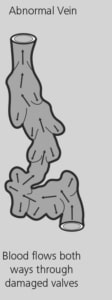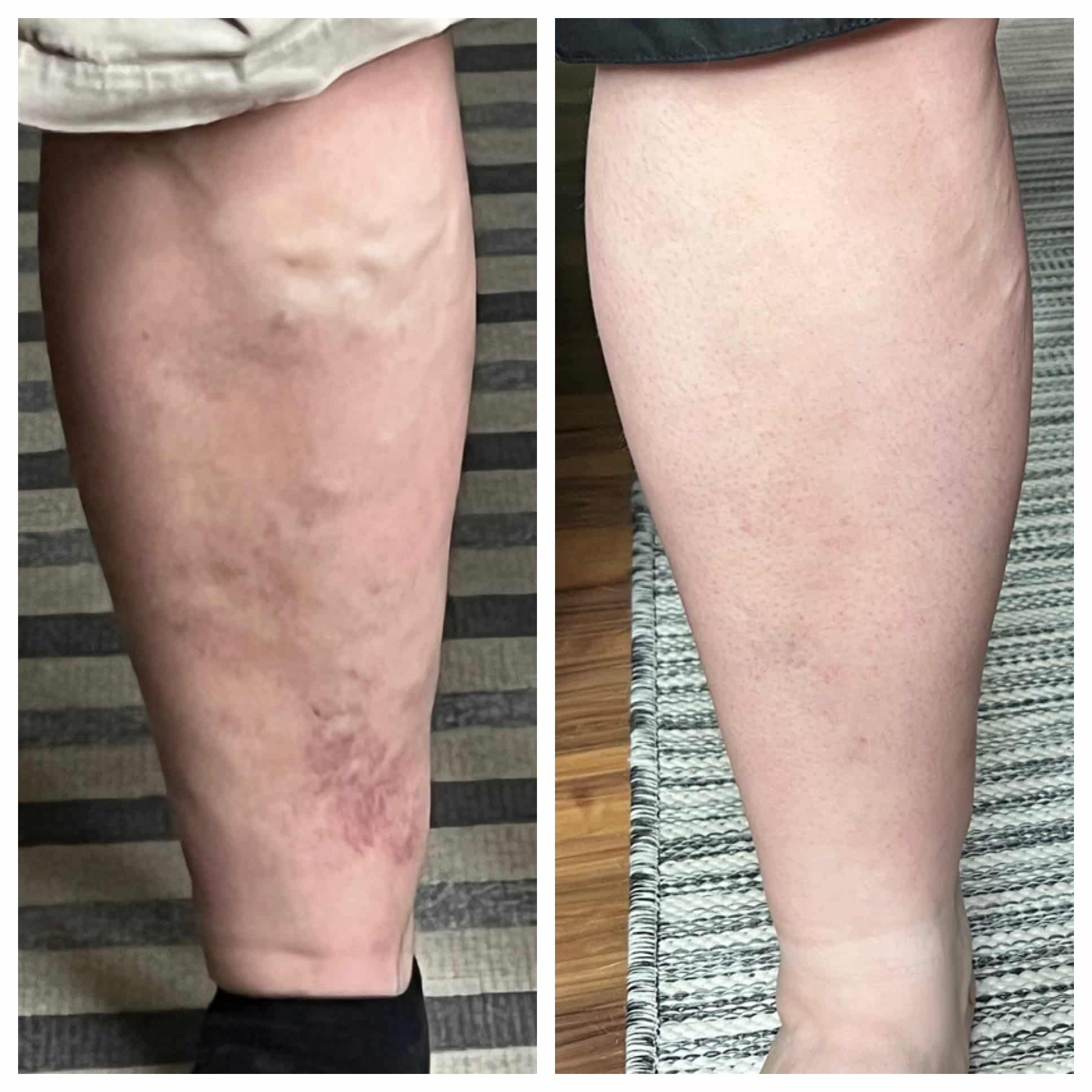An estimated 40 percent of people in the United States have chronic venous insufficiency. The Vascular institute of Virginia is a trusted vein treatment center of excellence. Venous insufficiency can present itself as a spider or varicose veins and may be a sign of significant underlying venous disease.
Venous insufficiency can be the result of heredity, age, gender, weight, history of deep vein thrombosis (blood clots), multiple pregnancies, inactivity and occupations that require prolonged sitting or standing.
What Are Varicose Veins?
When the veins are damaged, gravity will hinder normal blood flow causing blood to form pools in the weakened, damaged veins. The pooling blood causes these veins to enlarge. Twisted masses of veins beneath the surface of the skin, known as varicose veins, often result.
Varicose veins are larger and located deeper in the leg than spider veins. Spider veins are small red, blue and purple veins on the surface near the skin.
What Are the Symptoms of Varicose Veins?
- Aching/Pain
- Heaviness
- Tiredness/fatigue
- Itching/Burning
- Swollen ankles
- Leg cramps
- Restless legs
- Throbbing
Patient Testimonial
Who Is the Ideal Candidate for Varicose Vein Treatment?
A doctor may recommend varicose vein treatment such as sclerotherapy, endovenous laser therapy, or ambulatory phlebectomy in certain situation, such as:
- Varicose veins are large and unsightly.
- One or more varicose veins have become tender, swollen, or warm to the touch.
- Skin over the varicose vein has become discolored or rough in texture.
- Cramping, aching, sores, a heavy sensation, leg fatigue, or restless leg syndrome.
- A vein has started bleeding.
- Lifestyle remedies are no longer improving the condition.
Good vein treatment candidates also have realistic expectations related to cosmetic improvement based on their doctor’s input. Treatment cannot be performed on pregnant women or people taking a blood thinning medication, nor on patients with severe infection or illness.
How Are Varicose Veins Treated?
There are generally 2 treatment options:
- Conservative measures such as the use of compression stockings and change in lifestyle
- Corrective treatments such as endovenous laser therapy(EVLT), ambulatory phlebectomy, and sclerotherapy.

How Many Varicose Vein Treatments Will I Need?
Vein treatments can work very quickly in some cases and may take longer in others. It is difficult to predict exactly how many treatments a patient will need because we rely not only on the procedure but on the body to respond to the chosen modality. Treatment time can also depend on the type of treatment used.
ClosureFast and VensSEal by Medtronic are the two top treatments used at The Vascular Institute of Virginia. Treatments are simple and proven effective, but some patients may need a handful of sessions to achieve their desired outcome. We generally expect this to occur in one to three appointments.
Are There Permanent Treatments for Varicose Veins?
Varicose veins are treatable but not curable. This is because varicose veins form as a result of chronic venous insufficiency. This condition, in which the valves of some of the veins in the legs lose their strength, permanently damages those veins. They lose their ability to push blood back to the heart, so fluid pools in certain parts of the vein and causes swelling.
Will Varicose Veins Go Away on Their Own?
Neither varicose veins nor spider veins go away spontaneously. Even conservative treatments like compression and daily walking do not correct the issue. Once a valve loses its function and blood starts to stagnate, the vein is irreparable. That said, some people notice that their symptoms and the visibility of varicose veins may worsen at some times and improve at other times.
Veins often become more symptomatic in hot conditions and less so during the colder winter months. Symptoms may also improve with regular exercise. However, an improvement in symptoms does not indicate fully functioning valves in the varicose vein.
The team at the Metropolitan Vascular Institute uses gentle, minimally invasive modalities to address varicose veins. The purpose of varicose vein treatment is to allow blood to reroute through healthy veins so ropey swelling and other symptoms go away.
Can Varicose Veins Be Prevented?

It is not possible to completely avoid varicose veins because there are several factors that contribute to their development, including genetics.
However, some studies suggest that it is possible to reduce one’s risk of varicose veins by strengthening muscle tone and overall circulation. This can be done through:
- Regular exercise, especially types that strengthen the muscles of the lower legs.
- Eating a low-salt, high-fiber diet.
- Moving positions frequently throughout the day (avoiding sitting or standing for prolonged periods without movement).
- Wearing low-heeled shoes and avoiding tight hosiery.
- Maintaining a healthy weight.
- Elevating the legs to help blood flow more easily out of them.
How Do Varicose Veins Develop?
Blow flow returning to the heart is a tough climb out of the feet and up through the legs. Our muscles and the support tissues that surround our veins usually help push the blood upward by squeezing the veins slightly as we move our legs and feet. But as we age, these tissues weaken and don’t provide the same degree of support.
And the veins weaken, as well. Their walls become less rigid, and this allows the blood to push outward in spots, making the veins form a more meandering path. The valves that prevent backflow in the veins can also begin to fail or at least leak. This allows blood to pool in spots. This widens the veins.
All of this leads to the purple, often raised, curves of varicose veins. These are purple because they are carrying deoxygenated blood.
What Is Recovery Like After Varicose Vein Treatment?
Your recovery depends upon the method we’ve used to treat your varicose veins. With compression hosiery there isn’t any recovery; wearing them is an ongoing thing.
Sclerotherapy can only be used on smaller varicose veins, as too much sclerosant solution would be required in larger veins. Sclerotherapy doesn’t involve recovery. You can walk immediately afterwards and return to normal activities. You need to avoid strenuous exercise for a day or two after sclerotherapy, but that’s about it.
After we perform endovenous laser ablation of varicose veins, we’ll put you in a pair of compression stockings. These hose help ensure the vein stays closed and jumpstarts the process of the body eventually absorbing the now-unused vein. You’ll wear your stockings overnight for the first night. After that, you’ll wear them during the day for at least two weeks.
Before you leave our Vascular Institute of Virginia offices, you’ll be directed to take a 20-30-minute walk. Then you can drive home. From there, walking at least 30 minutes each day is mandatory.
You can return to normal activities immediately but should avoid standing still for long periods, and you’ll need to avoid long-haul flights for at least 3-4 weeks.
We will have you return for an ultrasound check of your treated veins two weeks after your treatment.
Varicose Veins Before & After Photos



What Results Can I Expect from My Varicose Vein Treatment?
At Vascular Institute of Virginia, our varicose vein treatments are very successful. Once we introduce the sclerosant in sclerotherapy or the laser energy, the vein walls collapse. This instantly closes off the vein, and the body reroutes any blood to an adjacent healthy vein. This should instantly flatten raised veins, but they will still be visually apparent. But the vein is now closed off for good, and the body begins the process of scavenging the vein and disposing of it. This process can take a couple months to fully remove the vein, but the difference is amazing.
Can I Still Get Varicose Veins After Having Treatment?
The veins we treat are gone for good. Once the vein walls have collapsed blood will not return to that vein. As described above, the body then gets down to the business of removing the vein and it will be gone in a period of weeks.
Does that mean your body can’t form another varicose vein? No. The same conditions that created the first vein or veins likely still exist, so another varicose vein can form. However, if you maintain a healthy weight, get regular exercise involving your legs, and avoid sitting or standing for long periods you can decrease your risk of developing new varicose veins. See the “Prevention” section on this page for more on that.
What Happens If I Don’t Have My Varicose Veins Treated?
Once a varicose vein has developed, it’s not going anywhere. The blood that has pooled, forcing the curling, raised vein won’t leave the vein. Does that mean it’s a health risk? No. But if the appearance of your raised veins bothers you that won’t change without treatment from the team at Vascular Institute of Virginia.
Varicose veins won’t typically worsen, but they can become painful even if they weren’t before. You can lessen this by wearing compression hosiery and getting more exercise, especially with your legs.
Complications can occur with untreated varicose veins, although they are rare. These include:
- Ulcers — These form on the skin near varicose veins, particularly near the ankles.
- Blood clots — Occasionally, veins deep within the legs become enlarged. In these cases, the affected leg may become painful and swell. This can indicate a possible blood clot, and this requires immediate medical attention.
- Bleeding — Occasionally, varicose veins very close to the surface skin may burst. This usually isn’t major bleeding, but medical attention is necessary when this happens.
Can Varicose Veins Be Painful?
Most varicose veins are a visual pain, but others can become physically painful. These are the painful signs and symptoms:
- An achy or heavy feeling in the legs
- Burning, throbbing, muscle cramping, and swelling in the lower legs
- Pain worsens after long periods sitting or standing
- Itching around one or more veins
- Skin discoloration around a varicose vein
Patient Testimonials
"VIV is a great place. It is very clean and the staff is wonderful and kind. I am always satisfied with the procedure that I have done & everyone is so professional."
"Excellent treatment and knowledgeable staff. Patients are treated with care and compassion and the facility is sterile and orderly. Thank you!!"
"They are very thorough. They make sure you understand your entire procedure from before, during and after."
"Very professional atmosphere and staff were very reassuring, too. They put me at ease before my procedure."
Schedule Your Consultation Today!
Interested in learning more about Varicose Vein Treatment with Vascular Institute of Virginia? Call 703-763-5224 to schedule your consultation today! Our practice serves Fredericksburg, Woodbridge, Fairfax & all nearby areas in Virginia.

